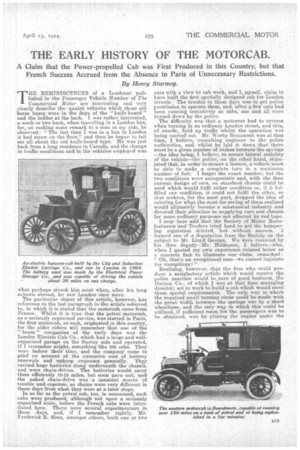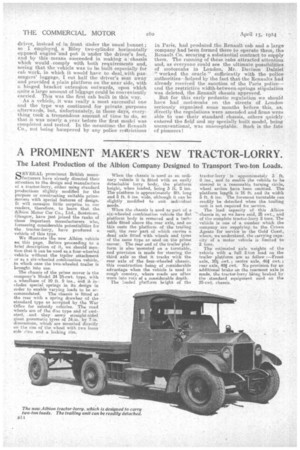THE EARLY HISTORY OF THE MOTORCAB.
Page 13

Page 14

If you've noticed an error in this article please click here to report it so we can fix it.
A Claim that the Power-propelled Cab was First Produced in this Country, but that French Success Accrued from the Absence in Paris of Unnecessary Restrictions.
' By Henry
Siurmey.
THE. REMINISCENCES of a Londoner published in the Passenger Vehicle Number of The Commercial Motor are interesting. and very clearly deSeribe the quaint vehicles which thoSe old horse buses were in the days of the knife-board" and the ladder at the back. I was rather interested, a week or two back, when travelling in a London bus; . for,on making some remark to a man at my side, he observed : "The last. time I. was in a bus in London it had straw on the floor," and then he began to tell . me all about the old knife-board 'type. He was just back from a long residence in Canada, and the change in traffic conditions and in-the vehicles -employed was
what perhaps struck him most when, after his long sojourn abroad, he saw London once more.
The particular object of this article, however, has reference to the last paragraph in the article referred to, in which it is stated that the motoreab came from France. Whilst it is true that the petrol Motoreal, as a seriously organized service, was started in Paris, the first motorcab, as such, originated in this country, for the older riders will remember that one of the " boom " companies of the early days was the London Electric Cab Co., which had a large and wellorganized garage on the Surrey side and operated, if I remember aright, something. like 100 cabs. They were before their time, and the company came to grief on account of the excessive cost of battery renewals and upkeep expenses generally. They carried huge batteries slung underneath the chassis, and were chain-driven. The batteries would carry them efficiently 70-15 miles, but soon gave out, and the naked chain-drive was a constant source of trouble and expense, as chains were very different in those days from what they were at a later stage.
In so far as the petrol cab, too, is concerned, such cabs were produced, although not upon •a seriously organized scale, before the French cabs were introduced here. There were several experimenters in those days, and, if I remember rightly, Mr. Frederick R. Sims, amongst others, built one or two cars with a 'view to cab work, and I, myself, claim to have built the first specially designed cab for London streets. The trouble in those daYs was to get police permission to operate them, and, after a few cars bad been running tentatively as cabs, one and all were turned down by the police.
The difficulty was that a motorcar had to reverse when turning in an ordinary London street, and this,
cure, held up traffic whilst the operation was being carried out. Mr. Worby Beaumont was at that time, I believe, consulting engineer to the police authorities, and whilst he laid it down that there must be a given number of inches between the springs —the idea being, I believe, to secure lateral stability of the vehicle—thu. police, on the other hand, stipulated that, in order to secure a licence, a vehicle must be able to make a complete turn in a maximum number of feet. I forget the exact number, but the two conditions were antagonistic and, with the then current. design of ears, no standard chassis could be used which would fulfil either condition or, if it fulfilled one condition, it could not fulfil the other, so that makers, for the most part, dropped the idea. of catering for what the most far-seeing of them realized would ultimately beer)]* a substantial industry and devoted their attention to supplying cars and chassis for more ordinary purposes not affected by red tape.
I may here add that the Society of 31otor Manufacturers and Traders tried hard to get the hampering regulation deleted, but without success. I formed one of a deputation from the Society on the subject to Mr. Lloyd George. We were received by his then deputy—Mr. Hobhouse, I believe—who, when I quoted my own experience related below as a concrete fact to illustrate our claim, remarked : "Oh, that's an exceptional ease--we cannot legislate for exceptions 1"
Realizing, however, that the firm who could produce a satisfactory artiele Which would receive the police sanction would b.c.sure of good business, the Duryea Co., of which I was at that time managing director, set to work to build a cab which would meet these special requirements. The only way in which the required small turning circle could be made with the great Width between -the springs was by a short wheelbase, and the only way in which this could he utilized, if sufficient room for the passengers was to be Obtained, was by placing the engine under the driver, instead of in front tinder the usual bonnet ; so I employed._ a Riley two-cylinder horizontally opposed engine-and put it under the driver's feet, and by this means succeeded in making a chassis which would comply with both requirements and, 'seeing that the vehicle was to be built especially for cab work, in which it would have to deal.with passengers' luggage, I cut half the driver's seat away and provided a plain platform on the near side, with a hinged bracket extension outwards, upon which .quite a large amount of luggage could be conveniently carried. This was the first cab built in this way. As a. vehicle, it was really a most successful one and the type was continued for private purposes afterwards, but, drifortunately, in those days, everything took a tremendous amount of time to do, so that it was nearly a. year before the first model was completed and tested. In the meantime the Renault Co., not being hampered by anypolice restrictions in Paris, had produced the Renaidt cab and a large company had been formed there to operate them, the Renault Co. securing it substantial contract to supply them. The runningof these cabs attracted attention and, as everyone could see the ultimate possibilities of nmtorcabs in London, Mr. Davison Dalziel " worked the oracle " sufficiently with the, police authorities—helped by the fact that the Renaults had already received the sanction of the Paris police— and the restrictive width-between-springs stipulation was deleted, the .Renault chassis approved. • But for this, early pedantic regulation we should have had inotorcabs on the streets of London seriously organized some months before this, ,as, directly the regulations were amended and firms were able to use their standard chassis, others quickly entered the field and my specially built model, being unconventional, was unacceptable. Such is the fate of pioneers






























